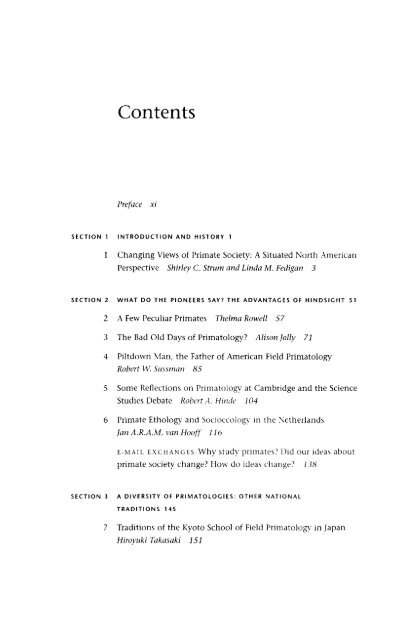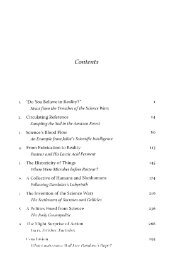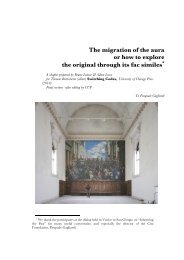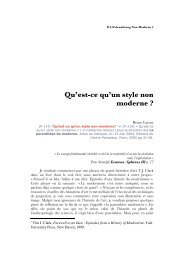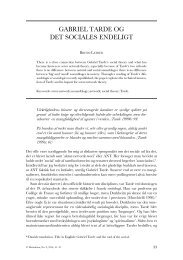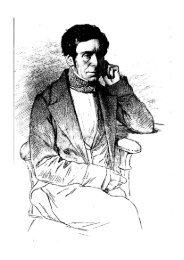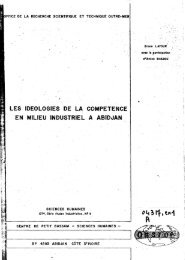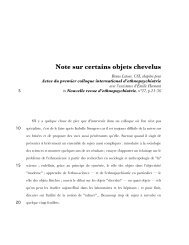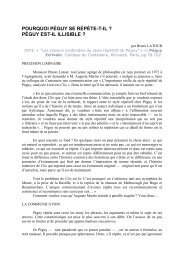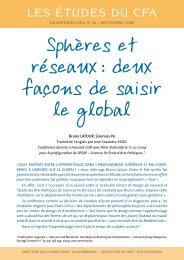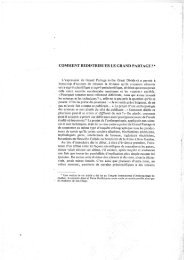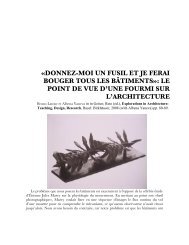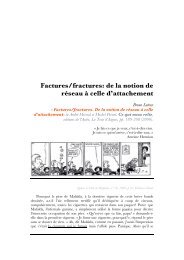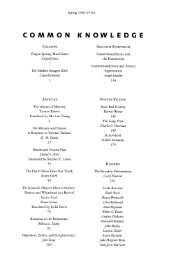A Well-Articulated Primatology - Bruno Latour
A Well-Articulated Primatology - Bruno Latour
A Well-Articulated Primatology - Bruno Latour
You also want an ePaper? Increase the reach of your titles
YUMPU automatically turns print PDFs into web optimized ePapers that Google loves.
s E c T t o N 1<br />
I<br />
s E c T t o N 2<br />
2<br />
3<br />
4<br />
Contents<br />
Preface xi<br />
I N T R O D U C T I O N A N D H I S T O R Y I<br />
Changing Views of Primate Society: A Situated North ,{rnerican<br />
Perspective Shirley C. Strum and Linda M. Fedigan 3<br />
W H A T O O T H E P I O N E E R S s A Y ? T H € A D V A N T A C E S O F H I N D S I C H T 5 1<br />
A Few Peculiar Primates Thelnn Rowell 57<br />
The Bad Old Days of <strong>Primatology</strong>? Alison lolly 71<br />
Piltdown \.{an, the Father of American Field <strong>Primatology</strong><br />
Robert W. Srrssnrrln 85<br />
Some Reflections on Prirnatolclgv at Cambridge and the Science<br />
Stu
Negotiating Science: Internationalization and Japanese<br />
<strong>Primatology</strong> Patnell Asquitlt 165<br />
Some Characteristics of Scientific Literature in Brazilian<br />
<strong>Primatology</strong> Maria Emilin Yrmttmoto and Anusks lrene Alencnr<br />
184<br />
10 An American Primatologist Abroad in Brazil Koren B. Strier<br />
191<br />
E-\14 IL EXCHAT'.GF-s:Why do Westerners accept Japanese data<br />
but not theory and practice? Are there manv primatologies or<br />
one international science? 208<br />
S E C T I O N 4 E N L A R G I N C T H E L E N S : C T O S E L Y R E L A T E D l S C l P l - I N E2S 1 5<br />
11 The Divergent Case of Cultural Anthropology Naomi Quitrn<br />
223<br />
1 2<br />
1 3<br />
7 4<br />
1 5<br />
Standpoint Matters-in Archaeologl', for Example<br />
Alison Wylie 213<br />
Paradigms and Primates: Bateman's Principle, Passive Females,<br />
and Perspecties from Other Taxa Zuleynn Tang-Martinez 261<br />
Culture, Disciplinary Tradition, and the Study of Behavior: Sex,<br />
Rats, and Spotted Hvenas Stephen E. Glicktnatr 275<br />
Changing Views on Initation in Primates Richard W. Bynre<br />
296<br />
E-MArL EXCHANGÊS:Did sociobiology make a difference in our<br />
ideas about primate society? Did women stud)'ing primates<br />
nrake a difference? 310<br />
S E C T I O N 5 M O D E L S O F S C I E N C E A N D S O C I E T Y 3 2 7<br />
16 Primate Suspect: Some Varieties of Science Studies<br />
Charis M. Thorttpson Clssirrs 329<br />
17 A \,Vell-<strong>Articulated</strong> <strong>Primatology</strong>: Reflections of a Fellow<br />
Traveler Bruto <strong>Latour</strong> 358<br />
1B Women, Gender, and Science: Some Parallels between<br />
Primatologv and Developmental Biology EvelT'tt Fox Keller<br />
i82
t 9<br />
20<br />
2 1<br />
lvlorphing in the Order: Flexible Strategies,<br />
Feminist Science<br />
Studies, and Primate Revisions Donna Harawoy 39g<br />
Life in the Field: The Nature of popular Culture in 1950s<br />
Arnerica Gregg Mihrtut 421<br />
Politics, Gender, and Worldly primatology:<br />
The Goodall-Fossey Nexus Brinn E. Noble 136<br />
E-\lArL EXClrAr.-GLS:The fight about science_why does it<br />
happen? Primatologists and the media-why do primatologists<br />
agonize about it? 163<br />
S E C T I O N 6 R E F O R M U L A T I N G<br />
T H E<br />
Q U E S T t O N S 4 7 3<br />
22 Science Encounters Sltirley C. Strunr 175<br />
23 Gender Encounters Lirtdn M. Feligon 198<br />
S E C T I O N 7 C O N C L U S I O NAS N D I M P L I C A T I O N 5S 2 1<br />
24 Future Encounters: The Media and Science; Gender ancl Science<br />
on the Periphery; The Science Wars; The Value of primate<br />
Studies; The Future of primates ancl prirnate Studies; Finale:<br />
Nerv Teams Slûrley C. Strum antl Lùultt M. Fetlisdn 523<br />
Relèrences 511<br />
Corttributor s 619<br />
Index 623
The Divergent Case of<br />
Cultural Anthropology<br />
Nnotni Quittrt<br />
 wontan sees hcrself being seen. Clutching her peltcil, slte rr.oncers hrr\r. ,,the<br />
discipiine" wilr 'i0w the wriling shc wants to do. wiil it he seen as too deri'ati\ c<br />
or male work? c)r too feninine? Too safe? or too riskv? Too seriousr or nalt<br />
srrious enough? Nran'er.es bore i, on her, rooring to see if she wiu do better<br />
or worse than rncn, or at least as $.ell as othel a.qn1sn.<br />
Rutlr Bt,hdr ( i995. 2)<br />
In this paper I trace the path that wonten studying gender,<br />
as a sometirnes rnore_ anci sontetinres less-iclentiûable<br />
group, have taken through the recent historv of one rliscipline,<br />
cultr-rral anthropologr'. As rrill l.rtc,rntr 311p;1rent, the<br />
cultural anthropology story is as nrucl-r about acadentic politics<br />
as about theoretical developments, irnplrcating the<br />
one deeply ir.r the other. In this respect, ,rine rs a cauti.nary<br />
tale for behavioral prinratologists. Marilyn Stratherr.r<br />
(19871 has argued that the sociar sciences contrast with the<br />
natural sciences simply in being fractious and fractured by<br />
nature, but I do not believe any academic discipline to be<br />
intmune to the kind of academic politics I will describe. On<br />
the other hand, we cannot assunle parallel developments<br />
in the two disciplines just because they happen to be rela_<br />
tives and happened in the 1970s to be swimmrng in the<br />
same intellectual currents when, along n,ith other behav_<br />
ioral and social sciences, both embarked on the renewed
A <strong>Well</strong>-Articulttted Pritrntology<br />
359<br />
type of causality, while the "culture" people would have insisted ad nauseam<br />
on the variability, pliability, and historicity of hurnan and animal<br />
behavior.<br />
Fortunately for all of us, we did not get stuck in these three different,<br />
but interrelated, false debates. Instead, we slowly and painfully moved<br />
toward another agenda that I would like to outline in this chapter by<br />
following, in three different sections, how each of those old and tired<br />
discussions was reconfigured, thanks to the extraordinary setup devised<br />
by the organizers and for which I am inhnitely grateful.<br />
The Vascularization of Science and Society<br />
The first originality of the meeting is to have brought together "science<br />
studies scholars" arrd scientists, who at ftrst were presented to each other<br />
as two "camps"-which appeared to me as bizarre as presenting prinlates<br />
as one camp and primatologists as another. Yet it was only a matter of<br />
time before things became far more complicated: alliances began to shift<br />
without obeying party lines. It was soon impossible to consider that there<br />
were only two sides, the frrst made up of those who believed data lvere<br />
fabricated out of thin air, and the second being those lvho believed they<br />
possessed an unmediated and indisputable access to the reality "out<br />
there. "<br />
The reason for this high learning curve is easy to understand in retrospect:<br />
"science studies" is to scientiRc practice what prirnatology is to primates.<br />
Without primatology, in order to speak of apes and monkeys, we<br />
would have to rely on a few anecdotes brought back bv missionaries and<br />
explorers; lve would have no data, no comparative basis, no nlore than<br />
the shabby represerltations of wilderness and savagerv n'itl.r n'hich \\restern<br />
culture has equipped us fiom the beginning. The challge in the qualin'of<br />
our representation of apes and monkeys might not be terribll" itnportant<br />
to the prin.rates-althougl.r it certainly does have an eiiect on the consL'rvation<br />
of many animal troops (see Strum this volume)-but it is certainhof<br />
great import to us as a human communitv. To deprive ourselves oi all<br />
the knowledge accumulated on primates in the last f,fty years (see Fecligarl<br />
and Strum this volume), would be an incredible loss.<br />
The same is largely true for science studies, although the rrlass of<br />
. knon'ledge is much smaller and the data softer (see<br />
'lhompsort Cttssit-ts<br />
this volurne). Without the empirical studies of scientists at rçork, we<br />
would be limited to anecdotes and myths about a few stuffed "great scientists"<br />
hung on the rvalls of the Universitl' Hall of Fanre. Science studies<br />
misht make little difference to scientists at the bench, since, after all, they
3 6 0<br />
Chapter Seventeen<br />
know what they do (as well as baboons know how they behave), but it<br />
would make a difference to all of us as a human conmunity. To deprive<br />
ourselves of the knowledge on the practice of science that has been accumulated<br />
over the last twenty years in the tristory, sociology, and pl-tilosophy<br />
of science, in order to go back to a sort of mid-nineteenth-century<br />
positivism, would certainly be a pity-although I must admit I preach<br />
for my parish. Whatever the assessment of the two disciplines and the<br />
differences in quality and status, the discussion cannot be productive if<br />
one accepts the empirical revolution it brought about in one's or,r'n, while<br />
shrugging off the other as irrelevant. In my opinion, by the end of the<br />
meeting, there was some agreement that to return to a n'orld made up of<br />
Dr. Livingstone's or l-ord Zuckerman's baboons would be no more possible<br />
than to backpedal into an epistemology peopled by ,Auguste Comte's or<br />
Karl Popper's scientists.<br />
This point being settled, the next problen-r to arise was that people at<br />
the conference were all well read in primatology, but very few had read<br />
much of the empirical work of the other discipline, science studies. To ask<br />
a sociologist of science, "Would you lump out of twenty-story building<br />
since vou belier-e gravity to be socially constructed?" is like asking a primatologist,<br />
"Monkevs are disgusting and promiscuous wild beasts, aren't<br />
the.v?" No ansn'er is to be expected and no answer should be givenexcept<br />
the one offered bv Donna Haraway: "Push the heckler through the<br />
n'indon'1" To produce knowledge about scientific practice and to debunk<br />
the mvthology of Science, capital S, is no more a der.rial of the reality of<br />
the scientific facts themselves than studying the social complexit,v of sexual<br />
competition and debunking the myth of the "wild beast" is a denial<br />
of the reality of the animals out there in the bush. Quite the contrary. To<br />
the question raised at one session, "What is responsible for the changing<br />
views of primates in the last fifty years?" the only answer I could f,nd was,<br />
"But the prbnates thertrselves of course, it is they who forced us to modify<br />
our account of them," exactly as I would have answered, "We learn every<br />
bit of the new'science studies' from the scientists themselves," if I had to<br />
explain the recent shifts in the definition of what science is and what<br />
makes it tick. "Please relax," I was tempted to say to some of my more<br />
anxious colleagues around the table. "Reality is not in question here."<br />
The debate does not oppose reality on one side and irreality on the other,<br />
but realities on both sides; or, more exactly, it opposes, on the one hand,<br />
a realistic version of what primates (and scientists) are and, on the other<br />
hand, a totally unrealistic or mythical vision of what primates (or scientists)<br />
do.<br />
If rve accept the cor.nparison of two entpirical disciplines and if we no\\'<br />
lear.e aside the red herring of reality versus "pure social construction,"
A We II- Articuhte d Pr imatology<br />
Public<br />
relations of the<br />
discipline<br />
Alliances and intere sts<br />
Mobilisation ol the u'orld<br />
Fig. 1. A sinrplihed vien of the tlows of knorvledge tfrom Latôur 1995a).<br />
361<br />
nothing is yet solved because the question becomes how did we nmke the<br />
prirnates themselves relevant to the questions we asked about them so that<br />
they could have a part in what we say of their behavior, while, before<br />
primatology started in earnest, thev had so little to say in the representation<br />
Westerners had of them. A little summary of science studies is indispensable<br />
at this luncture if we are to continue. In order to be clear and,<br />
alas, sketchy, I will use a simple diagram to git'e an idea of the amount of<br />
work necessary to rlake the primates accountable for ti.re facts produced<br />
by the discipline of primatology.<br />
If we had to study primatology, we would be interested in five different<br />
horizons of practice, each of them being simultaneously necessary to<br />
make a sciente productive.<br />
The first horizon-but one can start with any loop of figure 1 since it<br />
is a flow-is what can be called the "mobilization of the world," that<br />
is, all the efforts invested in creating a field site-or an enclosure or a<br />
laboratory-a data-producing unit. Every participant at the conference,<br />
including of course those in "science studies," knew only too rivell the<br />
imrnense effort that goes into obtaining a fleld site, maintaining it for any<br />
length of time, habituating tl-re animal, mapping the territor',', bringing<br />
the animals into the enclosures, caring for them, feeding them, equipping<br />
them with various devices, sarnpling them, etc. The beautv oi primatologv<br />
is the number of intermediary situations between field sites in unpro-
362<br />
Chaqter Seventeen<br />
tected areas all the way to brain surgery on animals held in laboratory<br />
conditions. The general point is that no matter how tnuch natural histori-<br />
ans like to get up early with binoculars and enioy sunrise in the bush,<br />
and no matter how much neurobiologists like to watch single-neurons<br />
f,ring up, they would immediately stop being scientists if they ceased to<br />
retum from their instruments-broadly conceived-with dûta that have<br />
the peculiarity of being highly trarrsformed information. A practicing sci-<br />
entist is never presented simply with information, but always with a<br />
transformation that should nonetheless maintain, as intact as possible,<br />
the features she is most interested in-hence the circular form I gave the<br />
loop (<strong>Latour</strong> 1995b).<br />
Although this work might account for B0 percent of the time spent,<br />
sweat and ingenuity is not enough to produce a discipline. Another vascu-<br />
larization is necessary. A scientist needs col/eagttes as ntuch as data, and<br />
the forrner is no easier to obtain than the latter. The second loop r,r'e must<br />
take into account, is that which can be designated as "autonomization of<br />
the discipline," which is as much hard work as tending to the instru-<br />
ments. What is a primatologist? A zoologist first and foremost? An anthro-<br />
pologist interested in early man? A sociobiologist following selfish genes?<br />
A psychologist? We all knor,r' how difficult it is to solve these questions.<br />
Everyorre at the conference was deeply aware of the frftv years of work<br />
that was necessarv to produce professional associations, journals, institu-<br />
tior-rs, conferences, ancl evaluation processes, so that the data painfulh'<br />
extracted fron-r the instruments could be made relevant and the various<br />
benefits from different experimental or naturalistic setups would be avail-<br />
able for comparison. Without colleagues, no quality control and thus no<br />
relevant data could be produced and made to circulate. A scientist who<br />
simply enjoyed fieldwork but who had no colleagues, rvould have no exis-<br />
tence and no visibility. He might just as well have staved in the bush<br />
fascinated by the beauty of the sunset.<br />
This is not the end of his work, however. In order to have data ancl<br />
colleagues, another enormous amount of work has to be done, this tintt<br />
spent on the third horizon called "alliances." Field sites are expensive ttr<br />
keep up, zoos are huge organizations, journals cost a fortune if they havt'<br />
good referees, graduate progrartts to recruit future colleagues are expert-<br />
sive, and laboratory tests are tinte consuming. No nratter how muclt .i<br />
scientist is interested in her anirttals and no matter hon' ntant'colleagLru<br />
she er-rioys having, she still has to interest rtorrscit'rttisfs in her prodttctio:<br />
systenr. A third vascularization is necessary that is in no waY externai , :<br />
subsidiary, but internal and coextensive with the n'ork to be done, arr':<br />
rvl-rich can lead a primatologist very far arn'ay from his colleagues to tl..<br />
strangest people, even the military (Haraway 1989). Arguments for cloir:-
A \'{ell-Articuloted Prhnatologv 363<br />
research must be provided, grant applications written, and relevant issues<br />
outlined. A scientist should approach his agencies and foundations with<br />
the same degree of enthusiasm he uses to convince his colleagues, or the<br />
same measure of concern he displays for his animals. No one said that<br />
being a scientist was an easy jobl<br />
Again, everyone in the room knew fairly well how urany nonprimatologlsfs<br />
were necessary to establish primatology as an autonomous discipline.<br />
A rough, but good, indicator would be to count the number of different<br />
institutions thanked in the acknowledgments of each of the papers produced<br />
by the people assembled in Teresopolis throughout their careers.<br />
One would quickly reach the hundreds. For each of them, rluch "networking"<br />
was necessary in order to persuade outsiders that their lives<br />
could not go on without first developing primatology. Without the translated<br />
interest of all these outsiders, the discipline as a whole rvould grind<br />
to a halt.<br />
But there is a fourth loop that is as essential as the other three, especially<br />
in the case of primatology: the "public relation" or the "public appeal"<br />
of a discipline. In addition to the "science studies" people, the organizers<br />
had invited several scholars interested in the public representation<br />
of apes and monkeys (see Mitman this volume and Noble this volume).<br />
As with the others, the discussion started off badly, with scientists cornplaining<br />
about being either distorted and manipulated by the media or,<br />
worse, ignored. But for this issue as well, the learning curve was high. It<br />
was soon clear to all that for a discipline that claims to be relevant to<br />
everything from the origin of rnan and \:onan, to the genetics of violence,<br />
to the antiquity of emotion and sex roles, to the necessity of conservation,<br />
it was utterly impossible to exclude the public-all the more so<br />
since it was public opinions that historicallv generated the interest of<br />
those who had become the discipline's allies in the former loop. Long<br />
before Darwin's da.v, the impact of primatolopçy and the question of the<br />
descent of man and its relation to the rest of the atrimal kingdom has<br />
made primatology an indispensable trading zone between ideologies and<br />
sciences. If we had forgotten this essential feature of the discipline, Donna<br />
Haraway's Primate Visions (1989) would have reminded us that frlnts, utuseums,<br />
advertisements, and popular culture all play an enorntous role in<br />
activating the whole of primatology, and providing much of its interest,<br />
passion, and energy. Here too, this vascularization is essential, and the<br />
comparison offered by the hyenas (see Glickman this volumel highlights<br />
how difflcult it is to work on animals which have a "public relation problem"<br />
and, by contrast, how difficult it is to deal with animals which are,<br />
scl to speak, "too much loved"l<br />
A scientist, however, is not only sweating to produce good data, disput-
364 Chapter Seventeen<br />
ing with her colleagues to have papers evaluated and accepted, and convincing<br />
agencies and foundations to finance her field study and local authorities<br />
not to trap her animals. She is not only making popular films,<br />
preparing slide shows, and organizing conferences to raise money and<br />
redress the image given her argument. She also has to think about how<br />
the whole flow of information (assessment, argument, money, image,<br />
myth) holds together as one coherent whole. The fifth horizon is no more<br />
and no less important than the other four. It can be called "concept,"<br />
"theory," or "paradigm." Contrary to many misconceptions, science studies<br />
are just as interested in this specific type of vascularization as in the<br />
four others. Concepts, however, are not colored lenses that would distort<br />
our view of things, to use the very unfortunate optic metaphor that will<br />
be criticized in the next section. Nor are they Platonic ideals floating far<br />
from the four other loops as if, in order to take seriously the "cognitive<br />
dimension of science," we had to escape to another world. Concepts are<br />
more like a beating heart that reoxygenates the blood, provided it is connected<br />
to the rest of the circulatory system. Yes, concepts are the heart of<br />
science, but one has rarely seen a functioning heart cut off from the rest<br />
of its body! "Male dominance," "kin selection," "proximate and ultimate<br />
causality," "bonobo scenario," and "selfish genes," to take a few examples,<br />
are highly complex integrations of masses of data, hunches, customs, and<br />
habits of thought, that cannot be easily discarded as irrelevant and cannot<br />
recapitulate vr'hat the whole discipline is about. When you isolate them<br />
from the rest vou have nothing. When you have the rest without them,<br />
it is like holding a disheveled skein of wool. Theories are highly practical<br />
operators that do not constitute an "inner nucleus" of science which<br />
could be excised out of a protoplasm.<br />
The point of quickly commenting on this five-horizon diagram is not<br />
to do the science study of primatology-although it would be a worthy<br />
task that Haraway and several others have already started-but to list the<br />
number of elements that should be taken into account to "make primates<br />
relevant to what they allow us to say about them." If a scientist were mad<br />
enough to brush aside all of these loops and scream in exasperation: "But<br />
let us get rid of all this sociology and history of science, of all these impedimenta-instruments,<br />
professions, journals, institutions, agencies, TV<br />
crews, exhibits, theories, concepts, paradigms-and let us go back to the<br />
animals themselves, let us seize them unfettered and unimpeded!" he<br />
would not produce a better knowledge. Instead, he would produce no<br />
knowledge at all and would be lost in the contemplation of a troop of<br />
fuzzy crealues even the names of which would escape him-since taxonomical<br />
labels reside in books, university training, databanks, and museums<br />
as well. Such a scientist might be enraptured by primates, but would
A WeII- A r ti c ul ate d P r i t n atol o 91'<br />
be lost to science, and so would anyone who would have failed to fulfill<br />
at once the contradictory tasks requested by four different horizons. Yes,<br />
science is hard work, and each of these mediations is necessarv to allow<br />
primates to have a say in our language. Our discourse can be accurate, but<br />
only on the condition that each of these transformations is carried out.<br />
Such is the great lesson of science studies: no one can jun.rp outside of<br />
mediations and speak in truth about the outside world. To cut science off<br />
from its rich vascularization is equivalent to killing it.<br />
It should be clear by now that the discovery of science studies is not<br />
that a science can be influenced or distorted by "outside" factors such as<br />
'fhe<br />
ideologies, politics, cultural biases, or psychological passions. discor'ery-if<br />
this grand word can be used for such a humble dlscipline-is<br />
much more interesting yet, and slightly resembles that, if I dare sar', oi<br />
the great William Harvey himself! "Facts" are circulating entities. Thev<br />
are like a fluid flowing through a complex network, a rough sketch of<br />
which has been given in figure 1. What circulates is a certain t1'pe of<br />
transformation that allows the world some bearing on what we say about<br />
it. Thus, the triple notion of an outside world of nature "out there," an<br />
inner core of science "in there," and a political or social domain "dorvr.t<br />
there," can no longer be sustained. When, during the conference, a silverback<br />
believes he is stating the obvious by saying: "We should not cotlfise<br />
our represer)tation of the chimps and what the chimps are doing out<br />
there," he is in fact asking us to split in two the rich vascularization that<br />
"science studies" aims at describing without artificial interruption. The<br />
only goal of the primatology discipline is precisell' to flnd tnany wa),s to<br />
mix, confuse, and intermingle n'hat "prinrates are doing out there" and<br />
"what we say about them." But to understancl this, a second false debate<br />
has to be pushed aside.l<br />
From the Metaphor of Gaze to That of Proposition<br />
The difficulty of integrating science studies and printatolog' n-as rein-<br />
forced during the meeting by the organizers' original intention to ;rrobe<br />
"the role of theory, method, and gender" in "the changing images of pri-<br />
mate societies." This earlier agenda, by its very forrnulation, coulcl clo<br />
nothing but paralyze the discussion since it imposed on eacl.t of us the<br />
fruitless task of purifying, in the sentences uttered about our animals,<br />
what depended on "them" and what depended on "us." If I have beel-t<br />
right in the former section, this would have been tantamount to severing<br />
all the vascularizations that make up a discipline, and striving toward the<br />
365<br />
impossible task of having animals, on the one haltd, and statements
166 Chapter Seventeen<br />
state of affairs<br />
r€sulting statement<br />
biases and theories<br />
Fig. 2. In the dualist model, a statement is the resultant beth'een tno opposite forces, what<br />
the rvorld is like and what we are equippetl to \aV about it.<br />
about them, on the other. with nothing in between. The dynamic of the<br />
meeting, however, slowlv eroded this original intention, and began to<br />
nudge us toward a completelv different set of metaphors. In order to be<br />
able to do the reflexive n'ork required of us, \ /e moved from an optical<br />
metaphor to a new one that I n-ill call "proposition."<br />
To be sure, the original irltention relied on a perfectly sturdy and venerable<br />
intellectual resource. t ikc in the "parallelogram of forces" we all<br />
learned at school, an\' statenrent about a state of affairs can be considered<br />
as the "resultant" of tn'o forces: what the world is like, and what n'e are<br />
equipped to sav about it. lf our biases are stronger, the resultant shifts<br />
toward one axis, n'hile, if the world is somehow strong enough, the staternent<br />
about it moves toward the opposite direction. With this classical<br />
rr.rodel, we inragine our statements to be twice constrained, not ottly by the<br />
world Duf also by our mental and cultural equipment. It thus makes a lot<br />
of sense to try to weigh the different components and to measure, for<br />
each historical period, which one is stronger and which is weaker.<br />
This model is obviously better than the naïve idea of science as an<br />
exact replica of the world, and it makes, I must confess, perfect commolt<br />
sense. Yet, it is utterly rlirolrg, since common sense is rarely a trustworthy<br />
guide in scientif,c matters. A simple thought experiment demonstrates<br />
tl-ris point easily. What would happen if there were no counterforce coming<br />
from the axis that I have called "biases and theories"? According to<br />
the model, it means that the resultant would be entirely determined by<br />
the state of affairs at hand. Thus, if we had no theory, no preconception,<br />
no bias, and no standpoint whatsoever, we would benefit from an indisputable,<br />
unmediated, pristine access to things in themselves. No laborator!'<br />
scientist would believe that for a minute. The same can be said of a<br />
natural historian-they know all too well the work needed To make a feature<br />
of the outside world lisiDle. During the conference, Steve Glickman<br />
prcsented us with a simple and startling example. Hyena ethologists had
A We I I -A rticul ate d P rimato I o gy 3 6 7<br />
waited for his paper published in 1990 to tell the difference betrveen a<br />
male hyena penis and a female clitoris! Since Aristotle's day, this question<br />
had been, if I dare say, pending. After reading his paper, the difference<br />
could easily be discerned with a few minutes of training, as we all could<br />
witness for ourselves (Frank, Glickman, and Powch 1990). To "make<br />
something" visible is thus an entirely different task than to calculate the<br />
resultant of a parallelogram of forces.<br />
The traditional model does not work any better if we push the couple<br />
of forces in the other direction and imagine a statement that is not counterbalanced<br />
by an1' constraint frorl the outside world. According to the<br />
diagram, it would mean that our statement about the world would be<br />
so/e/y dependent on our repertoire of m1.ths, prejudices, presuppositions,<br />
and biases, a pure story without anv grounding in the n'orld out there.<br />
No practicing scientist would believe this for a ninute. I-lorv could such<br />
exotic notions as kin selection, Machiavellian intelligence, social complexity,<br />
rnatriarchy, social tools, and pulses of testosterone, be devised<br />
without a Iong and thorough intimacy with the animals thenrselves?<br />
Where in the preexisting culture would these notions reside so as to construct<br />
these stories from scratch? No iûragination is fertile enough to produce<br />
even the r.nost simple facts of primatology. To take up the hvena's<br />
example once more, what the millenaries of cultural biases have taught<br />
us is nil comparecl to what we have learned since the opening of the<br />
Berkeley enclosure: repetitive siurs, endiess rumors-nothing that can<br />
even begin to articulate what makes hyenas' sexuality so specific. What<br />
the dualist model of a resultant between two opposite constraints does<br />
not explain is precisely \^,hat we want more dearly to understand: How<br />
do the animals out there contribute to how we imagine stories that no<br />
one without some level of intimate familiaritv could dream up? How<br />
could the setup we ceaselessll' devise elicit features in the lives oi the<br />
animals that were invisible to all before t,r-e start r.naking thenr up? Sureh.'<br />
a tug of war between two contrary forces will not do the lob.<br />
One sentence by Thelma Rowell will clearly ererlplifv the alterrrative<br />
model that was slowly seeping into our discussions. Speaking abor-rt her<br />
new study on sheep, she stated one of her "biases" in tl-re follorçing rvar-:<br />
"l tried to give my sheep the opportunity to behave /lkc chrnips, rrof that<br />
I believe that the,v would be like chimps, but because I anr sure tfrat ii 1'ou<br />
take slrcep fbr boritry slteep by opposition to intelligent chirnps ths' l'ollr/<br />
ttot have a clnnce" (my emphasis). What on earth could this little clause<br />
mean: "give my sheep the opportur-rity to behave"?<br />
A whole new philosophy of scientifrc practice resides irr this extraordinary<br />
statement: "to give the opportunity to behave" is not the same thing<br />
as "imposing a bias onto" animais that cannot say a thing. Rowell states
368 Chaqter Seventeen<br />
the difference between "a bias" and "an opportunity" very explicitly,<br />
since she insists that she does not believe sheep to be "like" chimps and<br />
since, left to their own devices, boring sheep will remain boring sheep<br />
forever. What does she mean, in my view? By importing the notion of<br />
intelligent behavior from a "charismatic animal"-another one of her<br />
treasurable expressions!-she might modify, subvert, or elicit, in the understanding<br />
of sheep behavior, features that were until then invisible<br />
because of the prejudices with which "boring sheep" have always been<br />
treated. She does not oppose, as in the dualist model criticized above,<br />
what sheep are really doing, with stories about them. On the contrary, it<br />
is because she artificially and willingly imposes on sheep another resource<br />
coming from elsewhere that "they could have a chance" to behave intelligently.<br />
But Thelma Rowell does not say that she is inventing sheep,<br />
socially constructing them, or making them up at her wishes. On the<br />
contrary, it is because of this very artificial collage between unrelated animals-charismatic<br />
chimps and boring sheep-that she can besf reveal<br />
what sheep really are. Her sentence would make no sense in the dualist<br />
paradigm portrayed in figure 2, since she would have to choose features<br />
according to an absurd question: Are the sheep really intelligent or did<br />
you invent what they are? Or is it a combination, a resultant of both?<br />
"None of the above," she should answer. "By placing them, quite deliberatel,v<br />
and quite artificiaily, into the paradigm of intelligent chimps, I gave<br />
them a chance to express features of behavior hitherto unknown. The<br />
more I work at it, the more autonomous my sheep may become."2<br />
Thelma Rowell's sentence is in no way exceptional. It is, on the contrary,<br />
the common parlance of practicing scientists. For them, intensity<br />
of work and autonomy of what their object of study does, are synotlytrlous.<br />
The better fabricated a fact, the more independent it is. Scientists behave<br />
as if they were "giving an opportunity" to phenomena that, in other settings,<br />
would not be "given a chance."3 However, what makes this very<br />
common way of talking disappear from the scientists' own philosophy of<br />
science-not to mention philosophy of science itseif, safely removed<br />
from all the empirical diffrculties of benches, enclosures, and freld sitesis<br />
the pervasive oPtical metaphor they have been made to use. If you transform<br />
all the actions that make the autonomy of scientific facts possible<br />
into "filters" that "color," "bias," or "distort" the view that a Saze should<br />
have of a phenomenon, then the very originality of scientific work becomes<br />
unaccountable. With the optical metaphor, the only reasonable<br />
outcome one can strive for is to gef rid of all the filters in order "to see<br />
things as they are." Thus the work necessary to make things visible has<br />
itself been made invisible, and every reminder by sociologists, feminists,<br />
anthropologists, epistemologists, and psychologists that there are indeed
A Wel I - Artic ul ate d P ri mato lo gy<br />
369<br />
"biases," "filters," "colored glasses," "preiudices," "standpoints," "paradigms,"<br />
and "a prioris" will be considered as so many ways to weaken Ihe<br />
quality of a science or to debunk its claim to truth. The only good gaze,<br />
according to the optical metaphor, is the one that is interrupted by<br />
nothing.<br />
The dynamics of the meeting in Teresopolis were fascinating to<br />
watch-difficult not to use the metaphor even when criticizing itlbecause<br />
the organizers rang a bell at every session trying to bring us back<br />
to a reflexive inquiry about "the role of theory, method, and gender in<br />
the changing images of primate society," while the dualist model under<br />
which we all operated to answer this question fell apart more and more<br />
completely as the days went on. Gender, for instance, did not appear as a<br />
filter that would make male and female scientists see things differently,<br />
blinding the males to some features while revealing others to the more<br />
perceptive female primatologists (see Keller this volume). At the conference,<br />
gender began to pla;t the same role as "intelligent chimps" in the<br />
sentence analyzed above. Not that of a filter or of a bias, but that of a<br />
trope, To use Donna Haraway's favorite word. In the striklng paper on the<br />
respective activity of eggs and sperm (see Tang-Martinez this volume), the<br />
importation to an unpredictable domain-reproductive physiology-of<br />
all the political debates in feminism over the dispatching of passivity and<br />
activity, allowed the ovum to "have the opportunity" of entering into a<br />
bewildering range of behavior instead of being considered as a "boring<br />
passive egg." The sessions on gender at the conference then shifted from<br />
a rather counterproductive soul-searching about whether or not a given<br />
primatologist was or was not "biased b,v gender, " to a much more interesting<br />
research program: How much activitl'can be granted any given entity<br />
if we accept using the "indignation against passivit\"' gained by decades<br />
of feminist struggle as a resource to "give a new chance" to an animal or<br />
to one of its components?<br />
The same shift quickly consumed the vague notion of theorv and<br />
method. When it is said that the Japanese method was to stav in the freld<br />
at least as long as an animal's life span (see Takasaki this volume), this<br />
obviously cannot be considered as a "bias" that would "limit" these scientists'<br />
vision of the animals. Quite the opposite. This simple decision entails,<br />
or reveals, different animals since it allows them to expand their<br />
interactions over a much longer period. This does not mean that those<br />
who go into the fleld for no more than a week with the sole purpose of<br />
collecting blood samples for their population genetics model are more<br />
"biased," but rather that they will give the animals a chance to behave<br />
differently. The same is true of important decisions like going to the field<br />
in Kenya instead of staying in an enclosure, or naming the animals indi-
370 ChaDter Seventeen<br />
vidually, or following them on foot instead of watching them from the<br />
safe haven of a jeep. Each of these moves allows for new differences in<br />
the animal to be elicited or educed. The de facto abandonment of the<br />
optical metaphor was clear to all in one of the sessions devoted to the<br />
role of theory, when the following contradictory verbs were all used to<br />
describe what various concepts were making us do: "interact," "focus,"<br />
"connect," "synthesize," "accelerate," "highlight," "raise a problem,"<br />
"provide a solution," "polarize attention," "shift attention," "legitimate,"<br />
"vindicate," "challenge," "stimulate," etc. Surely, all this very rich and<br />
active repertoire could not be squeezed under the label of "f,lter" or<br />
"standpoint" for an outside gaze looking at a thing out there. On the<br />
contrary, they made a lot of sense if theories are placed, like the fifth loop<br />
of ûgure 1, at the heart of several flows of data transformations.<br />
What other metaphor would do iustice to this practice and replace the<br />
old tired optical apparatus that limits the reflexivity of a scientific discipline<br />
to such an extent? In the paper prepared in advance for the conference,<br />
I had proposed, rather jokinglv, to shift from the gaze metaphor to<br />
a gas metaphor! This had the advantage of keeping with the fluidity of<br />
facts introduced in the first section. When you put gas into the tank of<br />
your car/ you are indeed connected with the oil fields of Saudi Arabia.<br />
These connections can certainly not be construed as so many "biases"<br />
which would have "distorted" the "real oil" out there. At the very least,<br />
if one wished away all these impedimenta, cracking, transformations,<br />
transportations, refineries, in order to gain access to the "oil itself," one<br />
would be left with no gas at all . . . The reality of oil in Saudi Arabia is<br />
proven by the number of transformations it undergoes before ending up<br />
as gas in your tank. So, with the gas metaphor, it is impossible to use the<br />
cracking and transformations of oil against the reality or against the quality<br />
of the final product. You have to choose either oil without transformation<br />
and thus no gas at all, or a lot of transformations but then you get<br />
gas instead of oil!<br />
This gas metaphor, however, does not do justice to the originality of<br />
scientific transformation. To be sure, it outlines well the circulation and<br />
fluidity of the reference and it nicely emphasizes the impossibility of interrupting<br />
the flow. But the relation between what we say about animals<br />
and what animals are like, is not that of gas and oil. In the case of primatology,<br />
animals are much more than the raw material of our knowledge<br />
about them. The more knowledge we have of them, the tnore visible they<br />
becorne. It is as if the pipeline was bidirectional, providing more oil when<br />
n'e have more gasl It is because a scientist fabricates the fact that it becorrcs<br />
independent from his work-hence the puzzling double meaning
A <strong>Well</strong>-<strong>Articulated</strong> <strong>Primatology</strong> 371<br />
of this little word "fact": what is made out, what is not made out. Clearly,<br />
this bizarre feature can't be sustained by the industrial nretaphor.<br />
Another way to better capture the practice of science is to consider<br />
preconceptions, biases, theories, methods, a prioris, and culture as so<br />
many roads that make it possible to gain access to the anintals themselves.<br />
Surely, no researcher at Gombe, for instance, will call the tinv trails that<br />
lead to the field site a "bias." It does not stand "in between" the prirr.ratol-<br />
ogist and his chimps. More exactly, it does stand itr bebyeett, but instead<br />
of being what harnpers the view of the chimp, as in the optical nretaphor,<br />
it is, without any doubt, what allows the chimps to enter into vien'. The<br />
same is true of provisioning crates, clearings, sampling methods, statisti-<br />
cal data reductions, binoculars, Jane Goodall's popular fllms, lectures<br />
given to the Leakey society, etc. All of these elements are in betrçeen,<br />
to be sure, but as so many indispensable mediations without rvhich no<br />
knowledge would be produced at all. No one will call the tarmac on n'l'rich<br />
planes are landing a "filter" that distorts what planes are supposed to be<br />
in themselves. The tarmac is, very commonly, what allows the plat-re to<br />
I a n d . . .<br />
The difference between the optical and the trail metaphor cornes from<br />
the geometry and the position of the scientist. In the gaze paradigm, the<br />
observer is fixed and so is the thing to look at. It is a still life and probably<br />
comes from a mistaken interpretation of classical paintings. In such a<br />
metaphor, any addition of an intermediary is taken as detrimental to the<br />
quality of the view. In the trail metaphor, on the contrary, the observer is<br />
not f,xed, but moves toward the thing to be seen, itself always in move-<br />
ment, and the more work that is dor.re on the intermediary, the better the<br />
data will be. In the latter metaphor, it is as if the vertical position of the<br />
successive filters had been shifted 90 degrees to turn then.r into a platform<br />
allowing the spectator to move on it. It was soon clear to us, during the<br />
meeting in Teresopolis, that all of the possible effects of theorr', ntethod,<br />
and gender on our knowledge of primates would be evaluated differcr.rtlv<br />
if, instead of being what cut us off from the animals, it becante n.hat<br />
gave the animal an opportunity to be seen. The veils that until then had<br />
obscured the view of the animals, now became the red carpet allon'ing us<br />
an effortless walk towards them . . .<br />
The trail metaphor is not without its defects, however, since it ntain-<br />
tains the idea that knowledge is vision and that observer and obsen'ed<br />
are quite independent from the route they take. None of this captures the<br />
originality of Theima Rowell's sentence. It is because she decided to treat<br />
sheep as chimps that they were lifted out of their condition of "boring<br />
sheep" and allowed the opportunity to demonstrate some intelligence.
3 7 2 Chapter Seventeen<br />
How can we explain this action of making something else visible? Either<br />
it is made, or it is visible, but how can it be made visible? How can we<br />
replace the passive resultant of the model we have now discarded by an<br />
action that seems to have contradictory features? To be sure, we could use<br />
the traditional vocabulary of fabrication and construction, but this might<br />
entail artificiality, invention, and even deception. If we say that facts are<br />
fabricated or constructed, we clearly imply, in the common parlance at<br />
least, that they have some innate vice that makes them forever unable to<br />
"fly." It seems that we have no way-in modern Western language at least<br />
flullien 1995)-to entertain the possibility of saying at once, in the same<br />
breath, fabricated fhus autonomous. We are always asked to choose "Is it<br />
real?" or, on the contrary, "ls it fabricated?" even though, in practice, we<br />
keep saying things like: "l tried to give my sheep the opportunity to behave<br />
like chimps."<br />
One way out of this difficulty might be to talk abovt propositions.a A<br />
Iittle bit of philosophy is necessary at this luncture, and I apologize to my<br />
colleagues for this little excursus, but it is crucial for allowing me, in the<br />
next section, to frnd another way of discriminating between good and<br />
bad science. As everyone will admit, the goal is worth a little pain!<br />
Propositions should not be limited to statements made of words uttered<br />
by a human "aoout" a natural thing. As the name indicates, they are<br />
offers made by an entity to relate to another under a certain perspective.<br />
Propositions are not limited to the human domain of language and consciousness.<br />
For instance, Uexkùll's canonical tick can be considered as a<br />
proposition and as a certain way of inhabiting the world by eliciting in its<br />
multiplicity a tiny number of relevant traits. To use another philosophical<br />
word, one could say that the tick "offers an interpretation of the world."<br />
But so does a fleld site with its research assistants on mopeds, its focus<br />
sample method, its archives, its portable computers, etc. The field site<br />
inhabits the world in a certain way and establishes certain types of connections<br />
that will modify the others. The passage of any hot-blooded animal<br />
will make the tick tick; the appearance of a new animal in the f,eld<br />
site will make all the assistants suddenly attentive. A statement says in<br />
words what a thing is. A proposition designates a certain way of loading<br />
an entity into another by making the second attentive to the Êrst, and by<br />
making both of them diverge from their usual path, their usual interpretation.<br />
A simple figure might help to grasp the abstract difference between<br />
a statement and a proposition.<br />
A statement pertains to the human language and is utterly separated<br />
bv an unbridgeable gap from the things it talks about. There is always an<br />
abvss between words and world, human and objects. This gap may be<br />
bridged, however, by the very mysterious act of establishing a correspon-
A We Il - Arti cul ate d P rim ato I ogy 373<br />
STATEMENT<br />
language world<br />
human I<br />
s"n<br />
l - l<br />
I<br />
conespondance<br />
\J<br />
l n a t u r e<br />
PROPOSITION<br />
diffe rence s<br />
Fig. 3. The difference between a statement in language about a reference, on the one hand.<br />
and a proposition, on the other, lies in the situation of the tw-o concepts: in the latter the difference<br />
between word and world is no longer pertinent.<br />
dence between words and world so as to provide the statement with a<br />
truth value. If, and only if, the cat is on the mat will the sentence "the<br />
cat is on the mat" be verifled. But since between the dimensionless sentence<br />
"the cat is on the mat" and a three-dimensional black furry cat on<br />
the mat there is no possible resemblance, the correspondence is always<br />
tentative and the gap between the two may never be fllled, no matter<br />
how many hundreds of thick tomes the philosophers of language have<br />
thrown into it. The word "dog" does not bark any more than the word<br />
"cat" purrs. Because of their infinite distance n'ith things-distance created<br />
artiflcially, for political reasons, by the erasure of all the intermediarv<br />
steps of data constructions-statements are aln'ar-s running the risk of not<br />
corresponding to the world in an exact way, thr-rs conder.nning the huntan<br />
Iocutor to life imprisonment, locked away in the cell of language. Skepticism<br />
directly descends from this implausible definition of truth as correspondence<br />
between words and the world.<br />
Propositions, on the other hand, do not pertain to language but to the<br />
world. This world, however, does not resemble a nature made of things<br />
foreign to human consciousness that has been made to stand like an enemy<br />
camp opposite the human camp. It is made of interpretations, or<br />
propositions, sent fo others so that they might behave differently. In between<br />
propositions there is thus not one gap but man,v tlifferences. Meaning<br />
is not obtained by this very implausible correspondence between language<br />
and oblects which have been made totally foreign to one another
i 7 4<br />
to begin with, but by connecting propositions which r.night or nright nrrt<br />
be slightly foreign to one another. While the notion of statements I)rovides<br />
no possible avenue for the thing to be made relevant to rr-hat rve<br />
say about it-except through the perilous footbridge of a correspondence<br />
between words and world-the notion of propositions allon's things tcr<br />
be loaded into words. Whereas a statement implies the existence of a<br />
talkative human surrounded by rnute things, a proposition impiies that<br />
we are made to speak in this way by'what is talked about. To understand<br />
this very tricky point in a less abstract way, we need to turn to the third<br />
debate of the conference-the most fascinating and also the most diftcult<br />
to elaborate.<br />
<strong>Articulated</strong> or Inarticulate Propositions<br />
After having circumvented the false debate to decide if primatology is or<br />
is not "socially constructed," and after the rather sterile discussion on the<br />
role of method, theory, and gender in "shaping our views" of primates,<br />
the conference could have gotten stuck in the traditional opposition between<br />
"nature" and "r'rurture," and all the more so given the feelings for<br />
and against sociobiologv, u'hich were as intense as those triggered by science<br />
studies. This is rvhere, from my point of view, the meeting was most<br />
rervarding. lt seems that we avoided the usual pitfalls by exemplifying in<br />
practice a new set of criteria to distirrguish good frotn bad science that completely'<br />
cuts across the old tired distinction between biological and cultural<br />
determinism. It is this shibboleth that I want to render more exDlicit<br />
in the last section of this chapter.<br />
I hope that Thelma Rowell will forgive me for analyzing her assertion<br />
about her sheep in more detail, but it provides the essential clue for my<br />
demonstration. As I said above, statements are different from propositions.<br />
This is especially clear if we consider how we make judgments about<br />
their quality. Statements are true or false depending on whether or not<br />
there is a state of affairs corresponding to the statement-with all the<br />
difftculties outlined by the philosophy of language. I u'ill propose to say,<br />
howevel that propositions are good or bad depending on whether they<br />
are articulate or inarticulate. "Boring sheep are boring sheep" is an inarticulate<br />
proposition since it repeats tautologically what a sheep is, as if refusing<br />
to enter into a connection with anything else. "Sheep are intelligent<br />
chirnps" is an articulated proposition since it offers to establish a connection<br />
between two completely different entities that will give meaning to<br />
both: in the ftrst sentence, sheep "are not given a chance," as Thelma<br />
said; in the second, they "will be given an opportunity to behave differ-
A <strong>Well</strong>-<strong>Articulated</strong> Primatctlogy 37s<br />
ently." The first sentence is a repetition-A is A. The second is, to use a<br />
philosophical term, a predication-A is B-that is, something else, on<br />
which it now depends to gain its meaning.<br />
The difference between articulate and inarticulate is not the same as<br />
between true and false. It is more like the difference between a musrc<br />
made of one note that remains at the same pitch and another that modu-<br />
lates the tone by shifting from one note to the other. Contrary to popular<br />
beliefs about science, it is very difficult to capture with some precision<br />
what scientists mean when they say that one piece of science is ,,interest-<br />
ing" and another "rubbisl.r." If dictionarv science is made up of statements<br />
that are simply true or false, science on the run, that is, research, is made<br />
up of propositions that also have rhr.'tl.rm, color, temperature, and tempo.<br />
When a scientist says that a proposition is "interesting,,,she does not<br />
only mean that it is accurate, but that it has a lot of other qualities as<br />
well: it can be warm, hot, surprising, fecund, productive, e_xciting. . . .<br />
When we insist on the distinction between bad and good science, rl.e not<br />
only distinguish between truth and falsity, but also betn'een repetitrve<br />
and articulate sentences. When we say that "data are meaningful,,,we<br />
thus designate another type of circulation than the one between a refere.nt<br />
out there and a statement in the language (see top of ûgure 3). We seem<br />
to designate a very specific kind of movement among propositions that<br />
rearrange themselves into new and unexpected combinations (see bottom<br />
of figure 3).<br />
We now understand why the debate about ,,social construction,, or<br />
"biases" was so fruitless. It was still connected with the linguistic and<br />
optical metaphors. The rnore intermediaries there were between the eye<br />
of the observer and the object-or betr,veen the statements of the scien-<br />
tists and the thing in itself-the /ess direct, and thus, the less accurate was<br />
the correspondence and the quality of the ir.rformation produced. Ideallv,<br />
according to this view, if there r.l'ere no interntediart' at all, no cor-r-rplica-<br />
tion whatsoever, the knowledge would be r.nore cclntplete. The situatior-r<br />
is entirely different with propositions. The rnore activit\. there is, ancl tl-re<br />
more intermediaries there are, the betrer the chance to articulate meaningful<br />
propositions. The difference between settings is not betn'een those<br />
where the scientists are inactive, remote, detached, disinterestcd, ancj autonomous,<br />
and tl-rose wl-rere they are active, constructive, busv fabricat-<br />
ing, or being biased, and full of a prioris and presuppositions. Instead, the<br />
distinction is between tl.re settings where all the activitv ends up ltroclucing<br />
repetitive data and those where the activity produces iltteresting artic-<br />
ulations. Once again, Thelrna offers an excellent exar.nple tr.l.rcn she castigates<br />
the farmers for constantll' separating sheep frour one another as<br />
soon as they demonstrate behavior that is not sheepish and panurgian.
376 Cha7ter Seventeen<br />
Farmers do not give the sheep a chance, whereas Thelma's setups are unusual<br />
because she actively counteracts the farmer's customs, allowing the<br />
sheep to establish hierarchies and social relations wherein they stand a<br />
slightly better chance of being socially complex.<br />
This case also nicely shows that propositions are in no way confined<br />
to language. The forms of life, in their entirety, in which farmers interact<br />
with sheep by selecting thern for their docility and sheepishness, will not<br />
allow them, i.e. the farmers, to let tlrcm, i.e. the sheep, Ûe tolked about in<br />
any other r,r'ay. Speech is not an exact propert,v of the human phonic<br />
apparatus, of the human inner subjectivity, of the human consciousness.<br />
It is more a property of the whole setting in which very heterogeneous<br />
elements have been gathered and connected: barns, enclosures, grass<br />
flelds, and r.t'ool in the farmers' fonn of life; barns, enclosures, grass fields,<br />
libraries, genes, papers, and ethological rneetings in Thelma's form of life.<br />
Whoever enters the farmer's setting lvill be tnade to sdl that boring sheep<br />
are boring sheep; whoever enters Thelma's quasi-laboratory will be made<br />
to say that sheep too ntav be "charismatic animals," in spite of the distance<br />
between primates and runrinantsl<br />
In practice, it is rrelt'r.thc case that ne utter statements by n-rerely using<br />
the resource of language and then only afterward check to see if there<br />
exists a correspondir-rg thing that will verify or falsif.v our utterance. No<br />
one has ever begurr bv sal,ing the "cat is on the mat" and thert turned to<br />
the proverbial cat to see whether or not it is sitting grar-rdly on the proverbial<br />
mat. Our involvement in what we say is at once much more intinnte<br />
and much morc indircct than that of the traditional picture: we are allowed<br />
to say new things when we enter well-articulated settings. Articulation<br />
between propositions is much deeper than speech. We speak because<br />
the propositions of the rn'orld are themselves articulated, not the other<br />
way around. More exactly, \r'e dre allowed to speak interestitrgh'b1'r+'hat we<br />
ollov,to speak interestirrgli'tDespret 1996). The notion of articulated propositions<br />
establishes entirely different relations between knower and known<br />
than the traditional view, but it captr.rres much rnore precisely the rich<br />
repertoire of scientific practice and is much better adapted to the reflexive<br />
task requested by the organizers' brief.<br />
A simple diagram might clarify the shift from one shibboleth to the<br />
other. The traditional touchstone tries to distinguish scientific statements<br />
about primates from rronscientific statements. The first t1,pe is said to corrcspond<br />
to a state of affairs "out there," while the other will be elaborated<br />
ll usir.rg only the resources provided at one time by the available stock of<br />
presuppositions, clichés, rnyths, a prioris, or paradigms, without the benetrt<br />
of anvthing "out there." To be sure, this touchstone provides a very<br />
Lr.tlul clinrension for sorting out dictionary science. But it does not can-
A \Uell-A rticulated P rimato I o gy,<br />
,,i<br />
F<br />
z<br />
!:l<br />
F<br />
.* non<br />
ô<br />
PROPOSITIO\S<br />
anlculate rnartrcu lulc<br />
ific A<br />
n I<br />
B<br />
scientific C D<br />
Fig. .1. The classical distinction between scientifrc and nonscientific statements i\ n()t
378 CInDter Seventeen<br />
active mediations to the greatest number of active entities. We were not<br />
trying to move from a naive science to a critical science, nor from a nonscience<br />
to an eventually scientiflc outlook, nor from a pure science to a<br />
polluted science, but from a science made from a certain number of active<br />
entities to another made of a greater number of them.6<br />
Let me give a few exanples to illustrate this point. The difference between<br />
the classical picture of active spermatozoa trying to penetrate a<br />
passive egg, and the new picture provided by Tang-Martinez, is not that<br />
the second is freed from gender biases while the former had been distorted<br />
by them; nor is it that the former was solely scientific rvhile the second<br />
brought in external factors borrowed from the larger culture to "contar.ninate"<br />
the scientif,c facts of physiologl. The difference is that the former<br />
leaves a large number of entities inactive, simply transporting necessity,<br />
while the second generates at every point active entities that, in part,<br />
modify the causality exerted onto them b.v the other. An egg that actively<br />
selects out spermatozoa differs front a passir,e egg not because it is nrore<br />
"feminine" or because it is studied by a radical femir.rist, but because it<br />
does more things and it is composed of more elements, more arficles, and<br />
more mediations, none of rn'hich can bc' reduced to a simple input and<br />
output blackbox. The same is true of Glickman's rats before and after the<br />
dernise of Skinnerian psvchology. The postbehaviorist rats are not more<br />
scientific than Skinner's rats. They do more things. They are made up of<br />
'l'hey<br />
ntore elements. are more articulate and so are the psychologists who<br />
use more diverse elements to talk about them. Simplification becomes<br />
harder; transports of necessity less easy. The same is true of "smart baboons,"<br />
"charismatic chimps," and "Machiavellian animals." No one<br />
claims that these represent more scientihcally what the animals are likealthough<br />
they obviously do; nor does anvone pretend that these are pleasing<br />
stories that are more in keeping with the prejudices of the agealthough<br />
they obviouslv are. Smart animals are more active in their own<br />
behavior and thus allorn' for more awareness on the part of the scientists<br />
studying them, forcing them to take more precautions, obliging them to<br />
become in turn more intelligent, more respectful.T<br />
The point of this very cmde indicator-the number of active entities<br />
and the number of active scientists-is to point out that articulation was<br />
a much more important element in the discussion than thle type of entity<br />
each of us tried to deal with. That they pertained to nature or to culture,<br />
to environrlent or to physiology, to science or to the history of science,<br />
to genetics or to feminist studies mattered /es-s than their degree of acti\'itv<br />
and their ability to reconflgure their inputs and outputs. This shibboleth<br />
can be applied to various elements, genes, horrnones, physiology,<br />
brain rvaves, and behaviors, without forcing us to resort to the image of
A llell-<strong>Articulated</strong> <strong>Primatology</strong> 379<br />
"levels"-the inferior level being considered as more determinant than<br />
the one preceding it. Reductionism is no longer an interesting issue. Thus,<br />
for instance, dealing with smart baboons who live in socially complex<br />
groups does not mean that primatologists coming from anthropological<br />
departments will be unwilling to deal with genetic determinism. They<br />
will simply be wary of a certain type of genetics that connects elements<br />
so as to decrease the number of active mediators. Also, itrside genetics the<br />
distinction between articulate and inarticulate propositions will sort out<br />
which parts of genetics are repetitive and simply scientific, and which<br />
parts are articulate and deal with a great many active "smart" genes and<br />
"smart" proteins, the pathways of which cannot be used for transporting<br />
an indisputable necessity.<br />
Glickman's hyena enclosure at Berkeley offers a magnificent illustration<br />
of what it means to deal with articulation. Every possible discipline<br />
is brought in, from endocrinology to ethology, from genetics to psychology,<br />
from anatomy to natural history, from media studies to the history<br />
of science, but not one of them is introduced to decrease the number of<br />
active entities elicited by another. Quite the contrarv: every time a new<br />
discipline appears, a new active entity is made visible that complicates<br />
the straight path of another. Glickman is not trying to integrate all the<br />
disciplines, each of them dealing with a certain "level" and defining an<br />
inflexible type of necessity. Instead, he is forcing all of the disciplines<br />
brought to the Berkelev enclosure to reconfrgure their defrnition of action<br />
at the occasion of new and puzzling features offered then.r by those hyenas<br />
to whom he has offered "the opportunitr." to behave intelligently and to<br />
be made up of entities, whereby each of them can be described as slightly<br />
sntdrter than before. "Off the shelf" endocrinologv lr,'ill not do the job any<br />
better than "off the shelf" population genetics or "off the shelf" histor;'<br />
of popular misrepresentations of hyenas. <strong>Articulated</strong> propositions cannot<br />
be easily traversed by indisputable necessities. From this enclosure, where<br />
scientists are rendered smarter by smarter hyenas who at last escape the<br />
terrible fate of being despisable Disney-like hyenas, no simplification<br />
about determinism can escape.<br />
The great advantage of this definition is that it also applies to the critical<br />
discourse bearing on primatology itself. When sorneone savs that<br />
"women primatologists see things differently because they arc \\'ontell"<br />
or that "Japanese scientists see things differently because thev arc Japanese,"<br />
it can mean two different things that are easy to distinguish if rve<br />
use the new touchstone. This introduction of an outside elemer.rt might<br />
play exactl.v the same repetitive inarticulate role as the one I'r'e trsed thus<br />
far as an example: "boring sheep are boring sheep," "wonren are women,"<br />
"Japanese are Japanese." The new entity is introduced-sex, culture,
380 Chapter Seventeen<br />
etc.-not in order to elicit a new feature from the other, but so as to<br />
maintain the essentialist character of the causality that has been brought<br />
in. It gives no more critical edge to the proposition than to say that //genes<br />
are genes" or that "Westerners always see things as Westerners." Tautology<br />
is always a tautology, no matter if it comes from the inside of science or<br />
from the outside, no matter if it deals with nature or culture, from ultimate<br />
or proximate mechanisms.<br />
But these new features may also mean something entirely different. By<br />
bringing in women scientists or Japanese researchers, this new original<br />
standpoint will introduce a difference that will lead away from the standpoint.<br />
Once again, it is Thelma Rowell who provided the best example of<br />
this shift when, to ridicule the notion of standpoint, she said in passing,<br />
"lf a female scientist studies female baboons and sticks to them she will<br />
end up studying males because female baboons are very much interested<br />
in males!" That's exactly the quality of a standpoint: it allows movement<br />
in a different way than what was intended. Standpoints never stand still!<br />
Because of the new attention given by female researchers to female baboons,<br />
a new attention will be given to males that differs entirely from<br />
the original focus on the domineering males and that differs a/so from the<br />
focus on the fernale that rlas originally intended. When we contend that<br />
primatologl' "betravs" many Western cultural biases about animals, monke1's,<br />
apes, or Dark Africa, that's exactly it: primatology betrays these original<br />
standpoints by turning them into something completely different.<br />
\\hat is true for the gene, for hormone levels, and for aggression is also<br />
true for history and the sociology of science: the carrying over of indisputable<br />
necessity is always less interesting, and, in the end, less scientiflc<br />
than the revelation of active mediators all the way down.<br />
If I am allowed some Gallic exaggeration, I would be tempted to say<br />
that the meeting in Teresopolis had an historical significance. Too often,<br />
scientists believe that their science will be better served if they ignore as<br />
much as possible all the untidy connections that make it work, with<br />
which they deal on a daily basis. They might be gathered to reflexively<br />
evaluate their discipline, but this evaluation, in their eyes, can only be<br />
carried out by using an off-the-shelf philosophy of science that dates back<br />
sixty years-to be charitable. The aim of such reflexive gathering could<br />
only be to purify the discipline ever more from the last remnants of adherence<br />
to subjectivity, politics, mythology, ideology, or biases. Shirley and<br />
Linda led us along an entirely different trail, which I have tried to map in<br />
dotted lines using my own system of projection. What would happen to<br />
the collective understanding of a discipline, if scientists were no longer<br />
trying to extirpate themselves from the sin of being connected, but accepted<br />
the vascularization as so many positive features that would turn
A \Uell-<strong>Articulated</strong> Primatolog) 38'l<br />
their science into a well-articulated one? <strong>Primatology</strong> would not only be<br />
crucially important as a trading zone between anthropology, zoology, evolutionary<br />
theory, ethics, conservation, and ecologli but also an exemplary<br />
site for the renewal of philosophy of science.<br />
N O T E S T O C H A P T E R S E V E N T E E N<br />
English in this chapter kindly corrected by Duana Fullwiley.<br />
1. I am well aware that this distinction between representation and things, or,<br />
to speak more philosophically, epistemological questions and ontological ones, is<br />
built in the culture for much stronger political reasons that have nothing to do<br />
with primates or Teresopolis. I have traced elsewhere part of this genealogy (La-<br />
t o u r 1 9 9 7 ) .<br />
2. The sentence is all the more interesting since it deals with a purely observa-<br />
tional etholoSy which has none of the usual features of laboratory experiments<br />
where it is always easier to show the artificiality of the setup (Hacking 1992|.For a<br />
treatment of a similar sentence by Louis Pasteur, see <strong>Latour</strong> 1996a.<br />
3. See the beautiful case studies by Despert (1996) on the theories devised bv<br />
A. Zahavi about Arabian babble. See Glickman (this vohrnte) on rrhat happened tr><br />
laboratory rats in the cages of the behaviorists.<br />
4. I have tried to rvork out this limit of the philosoçrhv of action by' devising<br />
the concept of "factishes" (<strong>Latour</strong> 1996b). For one possible use of this notion in<br />
epistemology, see Stenger 1996. The notion of proposition is a central concept<br />
in Whiteheadian metaphysics (Whitehead 1929 [197811.It has close connection<br />
with the debates between "saltationist" and "deambulatorv" conceDtions of truth-<br />
making (James 1907).<br />
5. For a more complete demonstration, see <strong>Latour</strong> 1999.<br />
6. The question of why is it that the "greater number of active entities the<br />
better" cannot be tackled within the confines of this chapter since it depends on a<br />
further redefinition of the difference between science and politics. For a first-effort<br />
go at it, see <strong>Latour</strong> 1999.<br />
7. This extends, as Despret (1996) has so elegantly shown, to those people rvho<br />
watch primatologists or ethologists at work: intelligence, so to speak, is infectious-<br />
s t u p i d i t y t o o . . .


